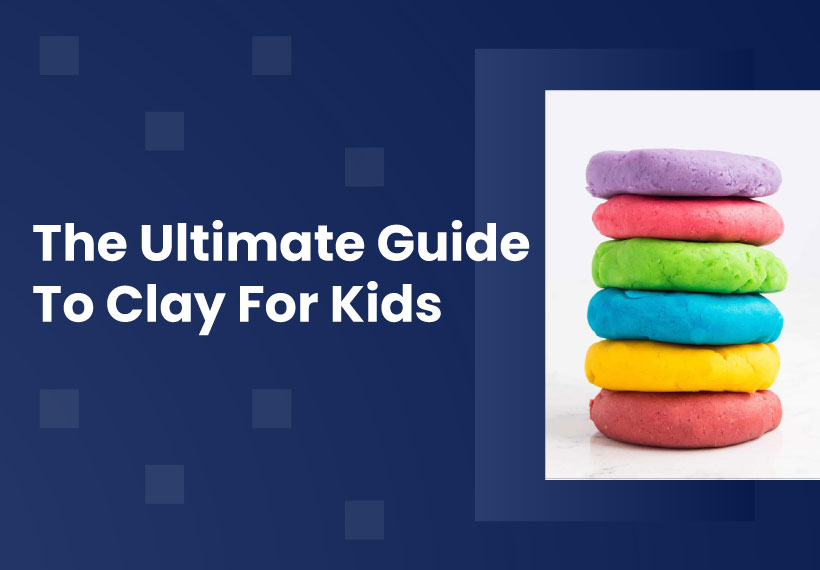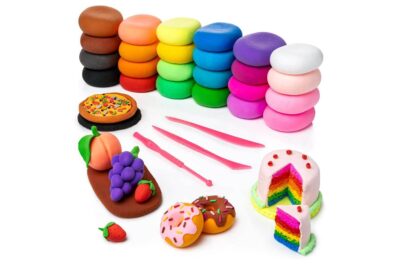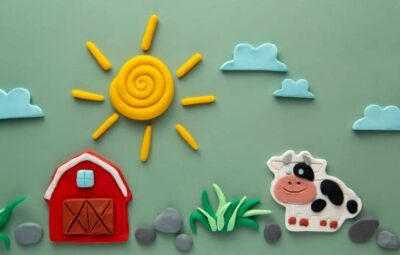The Ultimate Guide to Clay for Kids

In this ultimate guide, we will explore everything you need to know about clay for kids, from its types and benefits to safety tips and exciting project ideas.
If you’ve ever watched a child at play, you know how fascinating it is to see them transform simple materials into imaginative worlds.
One of the most versatile and beloved materials for kids’ creative endeavours is clay. The squishy, moldable nature of clay opens up a world of possibilities for young minds to explore.
Clay as a Creative Medium
Children possess an innate ability to turn the simplest of materials into works of art. Clay, with its tactile nature and endless possibilities, becomes a magical medium for them to explore.
Whether they’re rolling it, squishing it, or moulding it, clay holds a captivating allure that sparks creativity and imagination.
Exploring the Wonders of Clay
Imagine a child’s delight as they take a lump of clay and transform it into whatever their heart desires. From animals to vehicles and fantasy creatures to miniature landscapes, clay offers an open canvas for kids to shape their dreams.
Nurturing Creativity Through Hands-On Play
Engaging with clay isn’t just about crafting physical objects—it’s about fostering a creative mindset.
As kids manipulate the clay, they make decisions, experiment with shapes, and learn art fundamentals. This hands-on play cultivates problem-solving skills and encourages out-of-the-box thinking.
Types of Clay for Kids

When it comes to clay for kids, there’s no shortage of options. Each type of clay brings its unique characteristics to the table, catering to different preferences and project ideas.
Play Dough: The Classic Choice
Every child’s creative journey often begins with Play-Doh. This iconic modelling compound has been a staple in households and classrooms for generations.
Play-Doh’s soft texture and vibrant colours appeal to young children, encouraging them to shape and mould various forms.
It’s a fantastic tool for enhancing fine motor skills, hand-eye coordination, and sensory development.
One of the most excellent benefits of Play-Doh is its non-toxic and safe composition.
Parents and educators can rest assured that their little ones are engaging in creative activity without exposure to harmful substances.
From simple shapes to imaginative creations, Play-Doh is a beautiful stepping stone for kids as they embark on their artistic adventures.
Air-Dry Clay : Air-Dry Clay for kids

Air-dry clay is a user-friendly option that dries independently without firing in a kiln. This type of clay is often water-based and easy to handle, making it ideal for beginners.
Enter air-dry clay, a delightful medium that has captured the hearts and imaginations of kids and parents alike.
This versatile and user-friendly material opens up a world of artistic possibilities, allowing kids to sculpt, shape, and craft their way to colourful and imaginative creations.
The Magic of Air-Dry Clay
Air-dry clay is a dream for kids who crave tactile engagement and the joy of crafting. This pliable and soft clay doesn’t require the complex process of kiln firing; instead, it dries and hardens naturally when exposed to the air.
Its malleable texture is perfect for little hands, allowing children to experiment with various shapes and forms without the pressure of immediate perfection.
Benefits of Air-Dry Clay for Kids
Ease of Use: Air-dry clay is incredibly user-friendly, making it an ideal medium for kids of all ages.
Its forgiving nature means that even young children can dive in and start creating without feeling overwhelmed.
Fine Motor Skills: Working with air-dry clay enhances fine motor skills as kids use their fingers and hands to manipulate and shape the clay.
This can positively impact their handwriting, agility, and overall hand-eye coordination.
Sensory Exploration: The tactile nature of air-dry clay engages kids’ senses, providing a sensory-rich experience that encourages focus, concentration, and mindfulness.
Imagination and Creativity: Air-dry clay is a blank canvas for the imagination.
Kids can sculpt characters, animals, miniature landscapes, and more, giving life to their vivid ideas and storytelling.
Instant Gratification: Unlike other clays that require baking or firing, air-dry clay offers the satisfaction of seeing a creation come to life quickly.
This immediate reward boosts kids’ confidence and excites them about their artistic projects.
Fun Projects with Air-Dry Clay
Sculpting Animals: Let your kids’ creativity run wild as they shape adorable animals, creatures, and critters. From a cute cat to a friendly dinosaur, the possibilities are endless.
Hand-Print Keepsakes: Create cherished memories by pressing your child’s handprints or footprints into the clay. Once dry, you’ll have a wonderful keepsake that captures a moment.
Nature-Inspired Art: Encourage kids to explore the outdoors, collect leaves, twigs, and other natural treasures, and use them to imprint textures onto the clay.
This project celebrates nature’s beauty while fostering creativity.
Decorative Ornaments: With the holiday season or special occasions around the corner, crafting ornaments from air-dry clay is a fantastic way to personalize decorations and create meaningful gifts.
Storybook Characters: Bring beloved storybook characters to life by sculpting them 3D.
Kids can reimagine their favourite tales by crafting characters from their imagination.
Polymer Clay: Vibrant and Durable
As kids enter their tween and teen years, their artistic aspirations often become more detailed and refined.
Polymer clay offers a unique opportunity to create intricate designs and jewellery with professional-looking results. Unlike air-dry clay, polymer clay must be baked in an oven to harden.
One of the standout features of polymer clay is its ability to retain fine details. This makes it perfect for crafting miniature sculptures, beads, keychains, and other personalized items.
With a vast array of colours and the option to blend them, kids can explore endless possibilities in colour mixing and design.
Model Magic: Lightweight and Fun

Model Magic is an excellent option for a mess-free and lightweight clay experience. Created by Crayola, Model Magic has a unique spongy texture that is easy to manipulate and shape.
It dries to a light foam-like consistency, making it perfect for creating three-dimensional artwork that can be hung or displayed.
Model Magic comes in various vibrant colours, allowing kids to blend shades and create custom hues.
This type of clay encourages freeform sculpting, and its quick drying time enables children to see their creations come to life rapidly.
Model Magic is an excellent choice for kids who enjoy crafting without the mess of traditional clay.
Modelling Clay : Modeling clay for kids

Modelling clay, a classic and beloved medium, has inspired children’s creativity for generations.
This soft and pliable material comes in a rainbow of colors and encourages young artists to sculpt, mould, and create imaginative pieces.
Whether shaping characters, crafting miniatures, or experimenting with textures, modelling clay provides an exciting canvas for kids to explore their artistic talents.
Benefits of Modeling Clay for Kids
Enhanced Fine Motor Skills: Working with modelling clay requires careful manipulation and coordination of small movements, making it an excellent way to develop fine motor skills in children.
As they roll, shape, and mould the clay, kids are strengthening the muscles in their fingers and hands.
Sensory Exploration: The tactile nature of modelling clay engages multiple senses, allowing kids to experience texture, shape, and form through touch.
This sensory exploration enhances their perception and fosters a deeper connection to their creations.
Cognitive Development: Modeling clay encourages kids to plan, visualize, and execute their ideas.
As they transform their thoughts into three-dimensional forms, they enhance cognitive skills like problem-solving, spatial awareness, and critical thinking.
Creativity and Expression: Modeling clay is a versatile medium that invites kids to unleash their imagination.
Whether they’re crafting realistic figures or inventing fantastical creatures, children are given a platform to express their thoughts, feelings, and stories.
Relaxation and Focus: Working with modelling clay can have a calming effect on children.
The repetitive motions and engagement with the material promote relaxation and focus, providing an excellent way to unwind and de-stress.
Fun Projects with Modeling Clay
Character Sculpting: Let your child’s imagination soar as they sculpt their favourite characters from movies, books, or stories. From superheroes to animals, the possibilities are endless.
Miniature Food Creations: Craft adorable miniature versions of cupcakes, burgers, pizzas, and other foods.
This delightful project combines art with play and is perfect for tea parties or imaginative play.
Nature-Inspired Art: Take a nature walk with your child to collect leaves, flowers, and twigs. Then, use the modelling clay to recreate these natural elements, encouraging kids to appreciate the beauty around them.
Storybook Scenes: Bring beloved stories to life by creating scenes and characters from children’s books.
This project combines reading with hands-on creativity and can lead to imaginative storytelling sessions.
Custom Jewelry: Sculpt and design personalized jewellery pieces like beads, pendants, and bracelets.
Kids can mix and match colours to create wearable art that reflects their unique style.
Benefits of Clay Play for Kids
Clay play offers more than just creative amusement—it contributes to holistic child development in numerous ways.
Sensory Development and Exploration
The tactile nature of clay engages multiple senses, aiding in sensory development. Kids touch, mould, and shape the clay, enhancing their tactile perception and hand-eye coordination.
Fine Motor Skills Enhancement
Working with clay demands precision in manipulating small amounts of material. This hones fine motor skills, supporting writing, drawing, and intricate tasks.
Emotional and Expressive Outlet
Clay is a non-verbal medium for kids to express their thoughts and emotions. It’s a safe space for them to communicate their feelings by crafting a happy sun or a sad-faced character.
Next, we’ll guide you through selecting the correct type of clay for your child’s age and project goals.
Choosing the Right Clay for Your Child
Selecting the appropriate clay is crucial for a successful and enjoyable experience. Factors such as age appropriateness and the intended use of the clay should guide your decision.
Age Appropriateness and Safety Considerations
Certain clays, like play dough and model magic, are ideal for younger children due to their softness and non-toxic nature.
Older kids can explore more complex clays like polymer clay and air-dry clay.
Project Goals and Durability
Consider the projects your child is interested in. Polymer clay or air-dry clay are great choices if they want to create jewellery or lasting sculptures. If they enjoy spontaneous, temporary creations, play dough and model magic fit the bill.
With the basics covered, let’s set up the perfect creative space for clay play and introduce essential tools.
Getting Started with Clay Play
Creating a conducive environment for clay play enriches your child’s experience.
Setting Up a Creative Workspace
Designate a space where your child can comfortably play with clay.
Lay down protective covers and ensure proper ventilation, especially if you’re working with materials that require drying or baking.
Basic Tools and Accessories
Depending on the type of clay, gather tools like rolling pins, shaping tools, and cookie cutters. These tools enhance the sculpting process and allow for more intricate designs.
Moving forward, we’ll delve into safety precautions to ensure your child’s well-being during clay play.
Safety Precautions
While clay play is a fun and educational activity, safety is paramount.
Non-Toxic and Child-Friendly Options
Choose clays that are labelled as non-toxic and safe for children. This ensures that your child’s hands stay clean and that accidental ingestion poses no harm.
Cleanliness and Hygiene
Emphasize the importance of washing hands before and after playing with clay. Additionally, keep the play area clean and organized to prevent cross-contamination.
In the subsequent sections, we’ll walk you through exciting clay projects suitable for beginners, intermediate artists, and even advanced creators.
Simple Clay Projects for Beginners
For beginners, simple projects provide a great starting point for getting comfortable with clay.
Rolling and Shaping: Creating Basic Forms
Begin with basic shapes like balls, snakes, and squares. This helps kids understand how clay responds to different pressures and movements.
Pinch Pots: Crafting Small Vessels
Pinch pots are an excellent way to introduce kids to hand-building techniques. They can create small containers with their hands by pinching and shaping the clay.
Coil Creations: Making Spiraled Artworks
Coil projects involve rolling clay into long, thin ropes and shaping them into various forms. This technique allows for more intricate designs and structures.
Let’s move on to intermediate-level projects that expand your child’s clay skills.
Intermediate Clay Creations
As your child gains confidence in working with clay, they can move on to more intricate projects.
Miniature Sculptures: Animals, Flowers, and More
Challenge your child to sculpt miniature versions of their favourite animals, flowers, or objects. This encourages attention to detail and imaginative thinking.
Jewellery Making: Beads and Pendants
Polymer clay is perfect for crafting beads, pendants, and charms. Kids can explore colour blending and shaping to create unique jewellery pieces.
Creative Planters: Personalized Pottery
Transform simple air-dry clay into personalized planters. Kids can mould and decorate their pots, adding a touch of nature to their creative endeavours.
Let’s dive into advanced clay techniques that captivate older kids’ interest.
Advanced Clay Techniques for Older Kids
Advanced techniques offer new challenges for older kids who have mastered the basics.
Sculpting Faces and Figures
Challenge your child to create human or animal figures. This pushes their sculpting skills further as they learn to capture intricate details and proportions.
Exploring Textures and Patterns
Experimenting with different textures and patterns adds depth and visual interest to clay creations. From scales to fur, kids can explore a world of possibilities.
Multicolor and Layered Creations
Teach your child to blend and layer different clay colours to create dynamic, multicoloured artwork. This technique adds a new dimension to their creations.
As we progress, we’ll explore how clay play nurtures creativity and offers bonding opportunities for parents and kids.
Nurturing Creativity Through Clay Play
Clay play is more than just crafting—it’s a pathway to nurturing creativity and building stronger parent-child connections.
Encouraging Open-Ended Exploration
Encourage your child to explore without strict guidelines. Let them experiment with shapes, textures, and concepts, fostering their imaginative thinking.
Bonding and Learning Opportunities
Clay play provides an opportunity for parents to join in the fun. Collaborate on projects, share ideas, and create cherished memories together.
Moving forward, we’ll address crucial aspects like caring for clay creations and organizing playdates and workshops.
Caring for Clay Creations
Preserving the longevity and beauty of clay creations requires proper care.
Drying and Curing Methods
Different types of clay have varying drying methods. Follow manufacturer guidelines for air-dry clays, and bake polymer clay to achieve durability.
Painting and Sealing Finished Pieces
Once dried or baked, clay creations can be painted and sealed to enhance their appearance and protect them from wear and tear.
Organizing Clay Playdates and Workshops
Clay play can be a social and collaborative activity.
Collaborative Play and Learning
Organize playdates where kids can collaborate on projects. This encourages teamwork, sharing, and learning from each other’s techniques.
Sharing Tips and Ideas with Other Parents
Connect with other parents who share your interest in clay play: exchange tips, project ideas, and troubleshooting solutions for a richer experience.
Troubleshooting Common Clay Challenges
Even with the best preparations, challenges may arise during clay play.
Dealing with Cracks and Breaks
Cracks or breaks can occur during drying or baking. Learn techniques to repair and prevent such issues.
Preventing Clay from Drying Out
Air-dry clay and play dough can dry out over time. Keep them fresh by storing them in airtight containers and adding a damp cloth.
In the subsequent sections, we’ll explore how the benefits of clay play extend beyond childhood.
Clay Play Beyond Childhood
The joys of clay play don’t fade as kids grow up—it’s a medium that benefits individuals of all ages.
Therapeutic Benefits for All Ages
Clay play has therapeutic properties that aid in stress relief and mindfulness. Adults can enjoy sculpting as a form of relaxation and self-expression.
Exploring Professional Artistry
Clay play can evolve into an earnest pursuit for those passionate about art. Many renowned artists began their journey with clay, making it a stepping stone to professional artistry.
FAQs (Frequently Asked Questions)
Is clay play suitable for toddlers? Absolutely!
Playdough and soft clays are safe and enjoyable for toddlers, fostering sensory exploration and motor skill development.
Can you reuse dried-out play dough?
Revive dried-out play dough by adding a few drops of water and kneading it thoroughly. However, remember that this method might not work indefinitely.
Can adults benefit from clay play? Certainly!
Clay play offers therapeutic benefits for adults too. Sculpting with clay can be a calming and creative outlet, promoting relaxation and mindfulness.
Is polymer clay safe for kids?
Polymer clay is generally safe for kids to use, but it’s essential to supervise their play. Once baked, polymer clay becomes rugged and durable, reducing the risk of accidental ingestion.
Can I mix different types of clay?
Mixing different types of clay, like play dough and air-dry clay, might not yield desired results. Each clay type has unique properties, so it’s best to stick to one kind per project.
Conclusion
In this guide, we’ve unravelled the captivating world of clay play for kids.
As your child shapes their ideas into tangible creations, remember that clay play isn’t just about the end result—it’s about the journey of imagination, discovery, and growth.

